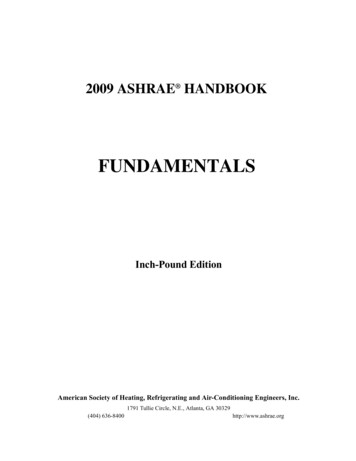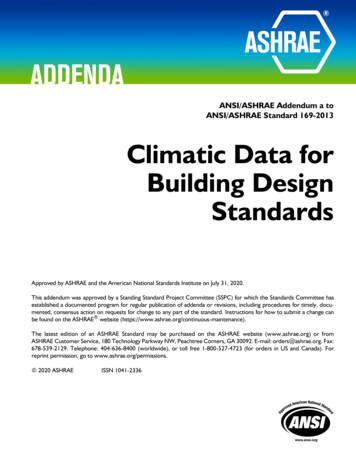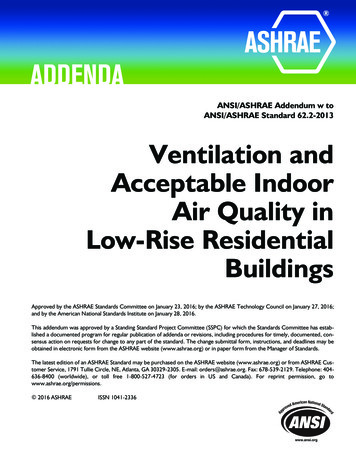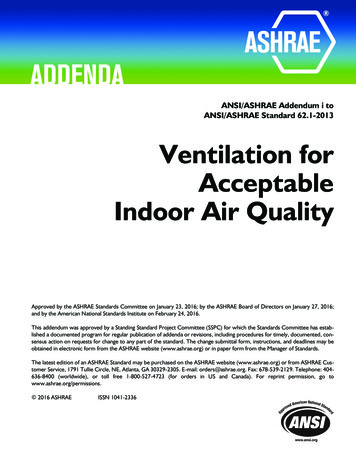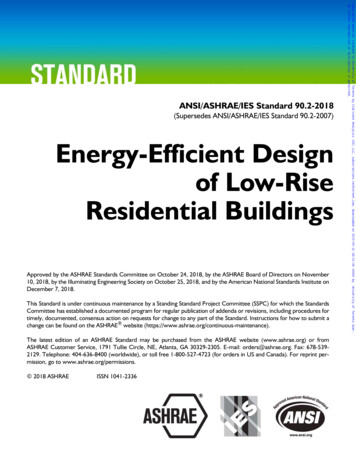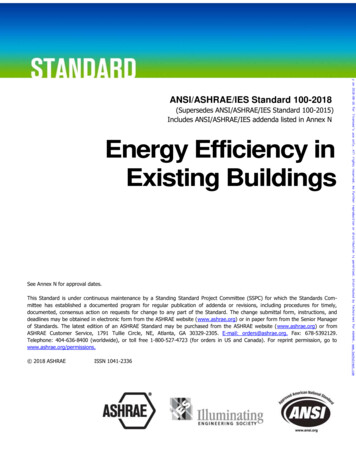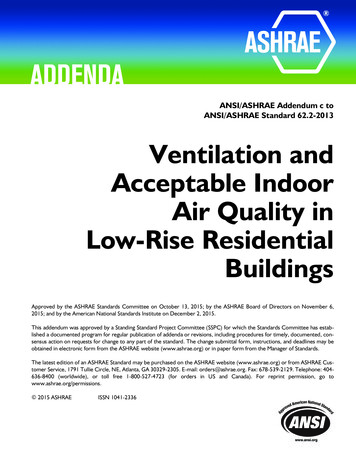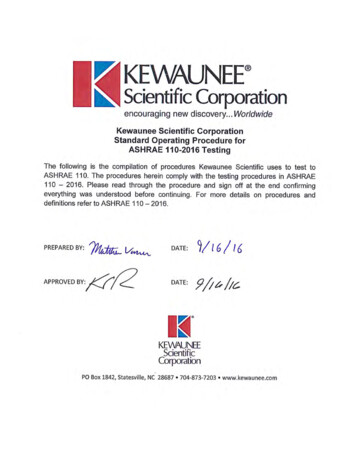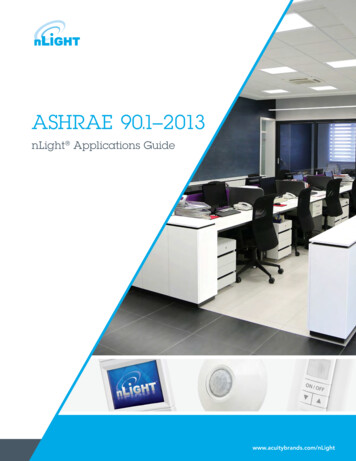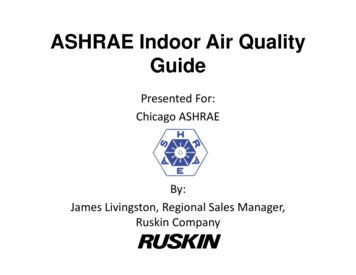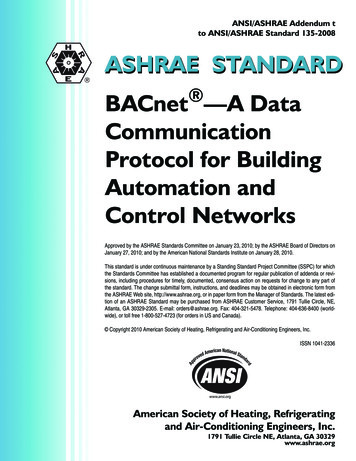
Transcription
ANSI/ASHRAE Addendum tto ANSI/ASHRAE Standard 135-2008ASHRAE STANDARD BACnet —A DataCommunicationProtocol for BuildingAutomation andControl NetworksApproved by the ASHRAE Standards Committee on January 23, 2010; by the ASHRAE Board of Directors onJanuary 27, 2010; and by the American National Standards Institute on January 28, 2010.This standard is under continuous maintenance by a Standing Standard Project Committee (SSPC) for whichthe Standards Committee has established a documented program for regular publication of addenda or revisions, including procedures for timely, documented, consensus action on requests for change to any part ofthe standard. The change submittal form, instructions, and deadlines may be obtained in electronic form fromthe ASHRAE Web site, http://www.ashrae.org, or in paper form from the Manager of Standards. The latest edition of an ASHRAE Standard may be purchased from ASHRAE Customer Service, 1791 Tullie Circle, NE,Atlanta, GA 30329-2305. E-mail: orders@ashrae.org. Fax: 404-321-5478. Telephone: 404-636-8400 (worldwide), or toll free 1-800-527-4723 (for orders in US and Canada). Copyright 2010 American Society of Heating, Refrigerating and Air-Conditioning Engineers, Inc.ISSN 1041-2336American Society of Heating, Refrigeratingand Air-Conditioning Engineers, Inc.1791 Tullie Circle NE, Atlanta, GA 30329www.ashrae.org
ASHRAE Standing Standard Project Committee 135Cognizant TC: TC 1.4, Control Theory and ApplicationSPLS Liaison: Douglas T. ReindlDavid Robin, Chair*Carl Neilson, Vice-ChairSharon E. Dinges, Secretary*Donald P. Alexander*Thomas ErtsgaardRobert L. Old, Jr.David M. FisherMark A. RailsbackJames W. FordJoseph R. ProkopCraig P. GemmillRon E. AndersonJerald GrilichesBeauford W. AtwaterDaniel P. GiorgisDonald S. BerkowitzIra G. GoldschmidtVictor BoedAlan D. ReinJohn I. RuizCarl J. RutherAnil SaigalJohn L. HartmanErnest SeniorDavid J. BransonWinston I. HetheringtonGideon ShavitBarry B. Bridges*David G. HolmbergColeman L. Brumley, Jr.Richard HoltzErnest C. BryantAnthony J. IcenhourSteven T. BushbyBernhard Isler*Patrick F. SheridanDavid G. ShikeKim E. ShinnStephen V. SkalkoJames F. ButlerRobert L. JohnsonA. J. CapowskiStephen Karg*C. Martel ChenWilliam R. KingKevin A. SweeneyJohn P. CiliaSimon LemaireDavid B. Thompson*Keith A. CorbettJeffrey CosiolTroy CowanHarsha M. DabholkarJ. Damian Ljungquist*Ted SunderlandWilliam O. Swan, IIIDaniel A. TraillJames G. LuthStephen J. Treado*John J. LynchDanny J. Wahlquist, Jr.Jerald P. MartocciJ. Michael Whitcomb*Robert A. DolinBertram W. MurpheyDavid F. WhiteTal ElyashivH. Michael NewmanGrant N. WichenkoDana R. EppersonCherisse M. NicastroRobert J. Zamojcin*Denotes members of voting status when the document was approved for publication
ASHRAE STANDARDS COMMITTEE 2009–2010Merle F. McBrideSteven T. Bushby, ChairH. Michael Newman, Vice-ChairRobert G. BakerMichael F. BedaHoy R. Bohanon, Jr.Kenneth W. CooperK. William DeanMartin DieryckxAllan B. FraserKatherine G. HammackNadar R. JayaramanByron W. JonesJay A. KohlerCarol E. MarriottFrank MyersJanice C. PetersonDouglas T. ReindlLawrence J. SchoenBoggarm S. SettyBodh R. SubherwalJames R. TaubyJames K. VallortWilliam F. WalterMichael W. WoodfordCraig P. WrayWayne R. Reedy, BOD ExOThomas E. Watson, COStephanie Reiniche, Manager of StandardsSPECIAL NOTEThis American National Standard (ANS) is a national voluntary consensus standard developed under the auspices of the AmericanSociety of Heating, Refrigerating and Air-Conditioning Engineers (ASHRAE). Consensus is defined by the American National StandardsInstitute (ANSI), of which ASHRAE is a member and which has approved this standard as an ANS, as “substantial agreement reached bydirectly and materially affected interest categories. This signifies the concurrence of more than a simple majority, but not necessarily unanimity.Consensus requires that all views and objections be considered, and that an effort be made toward their resolution.” Compliance with thisstandard is voluntary until and unless a legal jurisdiction makes compliance mandatory through legislation.ASHRAE obtains consensus through participation of its national and international members, associated societies, and public review.ASHRAE Standards are prepared by a Project Committee appointed specifically for the purpose of writing the Standard. The ProjectCommittee Chair and Vice-Chair must be members of ASHRAE; while other committee members may or may not be ASHRAE members, allmust be technically qualified in the subject area of the Standard. Every effort is made to balance the concerned interests on all ProjectCommittees.The Manager of Standards of ASHRAE should be contacted for:a. interpretation of the contents of this Standard,b. participation in the next review of the Standard,c. offering constructive criticism for improving the Standard, ord. permission to reprint portions of the Standard.DISCLAIMERASHRAE uses its best efforts to promulgate Standards and Guidelines for the benefit of the public in light of available information andaccepted industry practices. However, ASHRAE does not guarantee, certify, or assure the safety or performance of any products, components,or systems tested, installed, or operated in accordance with ASHRAE’s Standards or Guidelines or that any tests conducted under itsStandards or Guidelines will be nonhazardous or free from risk.ASHRAE INDUSTRIAL ADVERTISING POLICY ON STANDARDSASHRAE Standards and Guidelines are established to assist industry and the public by offering a uniform method of testing for ratingpurposes, by suggesting safe practices in designing and installing equipment, by providing proper definitions of this equipment, and by providingother information that may serve to guide the industry. The creation of ASHRAE Standards and Guidelines is determined by the need for them,and conformance to them is completely voluntary.In referring to this Standard or Guideline and in marking of equipment and in advertising, no claim shall be made, either stated or implied,that the product has been approved by ASHRAE.
2010 American Society of Heating, Refrigerating and Air-Conditioning Engineers, Inc. (www.ashrae.org). For personal use only.Additional reproduction, distribution, or transmission in either print or digital form is not permitted without ASHRAE’s prior written permission.[This foreword and the “rationale” on the following pages are not part of this standard. They are merelyinformative and do not contain requirements necessary for conformance to the standard.]FOREWORDAddendum 135t to ANSI/ASHRAE Standard 135-2008 contains a number of changes to the current standard. Thesemodifications are the result of change proposals made pursuant to the ASHRAE continuous maintenance procedures and ofdeliberations within Standing Standard Project Committee 135. The changes are summarized below.135-2008t-1. Add XML data formats, p. 1.In the following document, language added to existing clauses of ANSI/ASHRAE 135-2008 and addenda is indicatedthrough the use of italics, while deletions are indicated by strikethrough. Where entirely new subclauses are added, plain typeis used throughout.SSPC 135 wishes to recognize Joel Bender for the help he provided in developing this addendum.
2010 American Society of Heating, Refrigerating and Air-Conditioning Engineers, Inc. (www.ashrae.org). For personal use only.Additional reproduction, distribution, or transmission in either print or digital form is not permitted without ASHRAE’s prior written permission.135-2008t-1. Add XML data formats.RationaleA new standard way of representing building data will give BACnet new capabilities for standardizedcommunications between a wide range of applications. A definition for an XML syntax which can be used torepresent building data in a consistent, flexible and extensible manner is defined by this addendum in the form ofa new annex to the standard.The Extensible Markup Language (XML) is a popular technology in the data processing and communicationsworlds due to its ability to model a wide range of data and its ability to be transformed and extended. With thisnew IT-friendly way of representing building data, BACnet will open up a range of possible new ways to sharedata. XML can be used for exchanging files between systems, integrating buildings with energy utilities, andexpanding enterprise integration with richer Web services. Some of these new applications will be standardizedin future addenda to the standard based on the syntax defined here.This XML syntax defined in this annex is expected to be used in a wide variety of ways. Specific uses mayrequire surrounding XML beyond that which is specified here, but this addendum defines the core data definitionand data representation for all of the intended uses.This syntax is intended to be the core data representation for the following use cases:a. An electronic version of a PICS document, consumable by workstations and other tools, to describe thecapabilities of a device.b. An XML version of an EPICS, defining not only the capabilities of the device, but also including the completetest database and other test-oriented data.c. An "as built" description of a deployed device, distributed either as a separate file or as a File Object residentin the device itself.d. Descriptions of proprietary objects and properties and datatypes (in any of the above three uses). Thesedescriptions may be minimalistic, providing basic data sharing capabilities, or extremely rich, providingcomplete descriptions of the meaning and usage of the data to enable a comprehensive user interface,including the capability of providing such descriptions in multiple human languages.e. An export format for tools and workstations to export or publish their knowledge of the arrangement andconfiguration of a device or a complete system of devices and networks.f. Web services that exchange complex or constructed data.Addendum 135-2008t-1[This Table of Contents is not part of the standard. It is provided as an aid to the reader.]ANNEX X - XML DATA FORMATS (NORMATIVE) . 1X.1Introduction . 1X.1.1 Design . 1X.1.2 Syntax Examples. 2X.2Document Structure. 4X.2.1 CSML . 4X.2.1.1'defaultLocale' . 4X.2.1.2 Definitions . 5X.3Expressing BACnet Datatypes in XML . 5X.3.1 Common Attributes. 5X.3.1.1'name'. 6X.3.1.2'type' . 6X.3.1.3'extends' . 6X.3.1.4'overlays' . 7X.3.1.5'displayName' . 7ii
2010 American Society of Heating, Refrigerating and Air-Conditioning Engineers, Inc. (www.ashrae.org). For personal use only.Additional reproduction, distribution, or transmission in either print or digital form is not permitted without ASHRAE’s prior written permission.X.3.1.6'description' . 8X.3.1.7'comment' . 8X.3.1.8'writable' . 9X.3.1.9'readable' . 9X.3.1.10 'commandable' . 9X.3.1.11 'associatedWith' . 10X.3.1.12 'requiredWith' . 11X.3.1.13 'requiredWithout' . 12X.3.1.14 'notPresentWith' . 12X.3.1.15 'writableWhen'. 13X.3.1.16 'requiredWhen' . 14X.3.1.17 'writeEffective' . 14X.3.1.18 'optional' . 15X.3.1.19 'absent' . 15X.3.1.20 'variability' . 16X.3.1.21 'volatility' . 16X.3.1.22 'contextTag' . 17X.3.1.23 'propertyIdentifier' . 17X.3.2 Common Child Elements . 17X.3.2.1 DisplayName . 18X.3.2.2 Description . 18X.3.2.3 Documentation . 18X.3.2.4 WritableWhen . 18X.3.2.5 RequiredWhen . 19X.3.2.6 Extensions . 19X.3.3 Named Values . 19X.3.3.1 NamedValues . 20X.3.3.2'displayNameForWriting' . 21X.3.3.3'notForWriting' . 22X.3.3.4'notForReading' . 22X.3.3.5 DisplayNameForWriting . 23X.3.4 Named Bits . 23X.3.4.1 NamedBits . 23X.3.4.2 Bit . 23X.3.5 Primitive Values . 24X.3.5.1'value'. 25X.3.5.2'unspecifiedValue' . 26X.3.5.3'charset' . 26X.3.5.4'codepage' . 26X.3.5.5'length' . 26X.3.5.6 Value . 27X.3.6 Range Restrictions . 27X.3.6.1'minimum' . 28X.3.6.2'maximum' . 29X.3.6.3'minimumForWriting' . 29X.3.6.4'maximumForWriting' . 29X.3.6.5'resolution' . 29X.3.7 Engineering Units . 29X.3.7.1'units' . 30X.3.7.2 Units . 30X.3.8 Data Validity . 30X.3.8.1'valueAge' . 30X.3.8.2'error' . 31X.3.8.3 Error . 31X.3.9 Length Restrictions . 31X.3.9.1'minimumLength' . 32X.3.9.2'maximumLength' . 32ANSI/ASHRAE Addendum t to ANSI/ASHRAE Standard 135-2008ii
2010 American Society of Heating, Refrigerating and Air-Conditioning Engineers, Inc. (www.ashrae.org). For personal use only.Additional reproduction, distribution, or transmission in either print or digital form is not permitted without ASHRAE’s prior written permission.'minimumLengthForWriting'. 32X.3.9.3X.3.9.4'maximumLengthForWriting' . 33X.3.9.5'minimumEncodedLength'. 33X.3.9.6'maximumEncodedLength' . 33X.3.9.7'minimumEncodedLengthForWriting' . 33X.3.9.8'maximumEncodedLengthForWriting' . 33X.3.10Collections . 34X.3.10.1 'minimumSize' . 34X.3.10.2 'maximumSize' . 34X.3.10.3 'memberType' . 34X.3.10.4 MemberTypeDefinition . 35X.3.11Representing Primitive Data . 35X.3.11.1 Null . 35X.3.11.2 Boolean . 35X.3.11.3 Unsigned . 36X.3.11.4 Integer . 36X.3.11.5 Real . 36X.3.11.6 Double . 36X.3.11.7 OctetString . 36X.3.11.8 String . 36X.3.11.9 BitString . 36X.3.11.10 Enumerated . 37X.3.11.11 Date . 37X.3.11.12 DatePattern . 37X.3.11.13 DateTime . 38X.3.11.14 DateTimePattern . 38X.3.11.15 Time . 39X.3.11.16 TimePattern . 39X.3.11.17 ObjectIdentifier . 39X.3.11.18 ObjectIdentifierPattern . 39X.3.11.19 WeekNDay . 40X.3.12Representing Constructed Data . 40X.3.12.1 Sequence . 40X.3.12.2 Choice . 41X.3.12.3 Array . 41X.3.12.4 List . 42X.3.12.5 SequenceOf . 42X.3.13Representing Data of Unknown Type . 42X.3.13.1 Any . 42X.4Expressing BACnet Objects and Properties in XML . 43X.4.1 Object . 43X.5Definitions, Types, Instances, and Inheritance . 43X.6Binary Encoding and Access Rules . 49X.7Extensibility . 50X.7.1 XML ex
ASHRAE Standards are prepared by a Project Committee appointed specifically for the purpose of writing the Standard. The Project Committee Chair and Vice-Chair must be members of ASHRAE; while ot her committee members may or may not be ASHRAE members, all must be t
